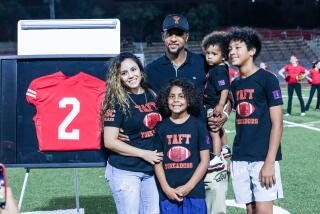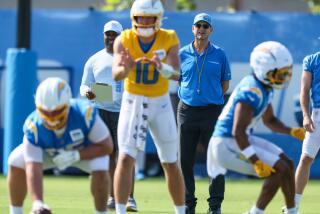Tapping His Potential : Late Start Didn’t Slow Al Carmichael
- Share via
PALM DESERT — It became a ritual in Al Carmichael’s home in Inglewood during the early 1940s.
Fall rolled around, and Carmichael would beg his parents to let him play tackle football, first in youth leagues, then in high school. His parents would say, “No, that’s too dangerous, we don’t want you getting hurt.” Carmichael would take out his frustrations on the sandlot.
Carmichael was a pad-less wonder on the playground, where kids counted to “Five Mississippi” before they could rush the quarterback, but that didn’t satisfy his craving for real football.
Then, during his junior year at Gardena High School, Carmichael’s father fell ill with cancer. Preoccupied with the disease, his parents didn’t have the energy to fight Al about football.
By the fall of Carmichael’s senior year, they relented. Al could play.
Unfortunate circumstances led to the decision, but it was a fortunate turn of events for Carmichael’s athletic career.
Carmichael’s father died during his senior season--his first in organized football--a season in which Carmichael was the leading rusher on Gardena’s 8-0 team.
He went on to star for the El Toro Marine Air Corps Station, Santa Ana College, USC and the Green Bay Packers.
He gained about 1,000 yards in each of two years at the El Toro Marine Air Corps Station.
He rushed for 1,100 yards and 19 touchdowns to lead Santa Ana College to a 10-1 record and a berth in the 1949 Junior Rose Bowl, where the Dons were beaten in the last minute, 21-19, by Little Rock, Ark.
He started three seasons at USC, where he ran for 1,166 career yards and caught the game-winning, 22-yard touchdown pass in the Trojans’ 7-0 Rose Bowl victory over Wisconsin in 1952.
He spent six years in Green Bay, where he played running back, flanker and returned punts and kickoffs. He still shares the NFL record for longest kickoff return, 106 yards against the Chicago Bears in 1956, a feat matched in 1967 by Kansas City’s Noland Smith and in 1979 by St. Louis’ Roy Green.
Carmichael has been inducted into the Junior College Hall of Fame, the All-Service Hall of Fame and the Green Bay Packers’ Hall of Fame. Tuesday night, he’ll add another achievement, when he’s inducted into the Orange County Hall of Fame.
And to think, Carmichael’s athletic potential almost went untapped.
“I was talking to my mom last month and she doesn’t remember keeping me out of football,” said Carmichael, now 63 and selling real estate in the Palm Springs area. “But when I started playing, she became my most ardent rooter.”
Carmichael had a knack for bringing fans to their feet with his running style, which blended breakaway speed with power and was extremely effective in the open field. He was timed in the 100-yard dash at 9.8 seconds.
“He had a high knee action and was more powerful than people thought,” said Marv Goux, a USC teammate of Carmichael’s who now works in the Rams’ speakers bureau. “He was very explosive, and his legs were always churning. He had a good stiff arm, and you never got too close to him.”
After high school, it seemed as if Carmichael might not get close to another football team. He made a three-year commitment to the Marine Air Corps and was stationed at El Toro, which had an outstanding football team that could compete with many college teams.
Dozens of players, including some 15-20 halfbacks, tried out for the team, and some members had already played in college. The equipment man told Carmichael not to even bother going out for the team, but Carmichael persisted and was issued leftover gear.
“My pants didn’t fit, the helmet didn’t fit and the pads were too big,” Carmichael said. “I looked like a clown.”
Carmichael was released after the first day of tryouts without getting a chance to play. He complained that he didn’t get a fair shake and the coach, Capt. Ed Cornwall, told him to come to a scrimmage the next day.
Carmichael came, he saw, but had no chance to conquer. He was told to come back the next day. Again, he didn’t play.
After the third scrimmage, Cornwall sent Carmichael to a field to return punts. There were six defenders, but Carmichael had no blockers. It was raining, and the field was slick.
Carmichael caught the punt, beat the six defenders and scored a touchdown. He remembers Cornwall’s response: “Are you guys (defenders) gonna let this clown go through you like that?”
The next punt, Cornwall sent eight men out at Carmichael, who eluded many tackles and scored again. Just to make sure it was no fluke, Carmichael scored a third time.
“After that, Cornwall called the equipment man,” Carmichael said. “He said, ‘Get this guy a uniform that fits. We’ve got a ballplayer here!’ What’s kind of funny is years later, Cornwall spent the day on the Packers’ sideline with me when we were playing the Bears (in Chicago).”
Two weeks before El Toro’s 1947 season, a starting halfback broke his leg and Carmichael moved into the lineup. He remained there two seasons, leading El Toro to a 20-2 record and two 11th Naval District Division championships.
Carmichael went on to Santa Ana College, where he earned Little All-American honors in 1949. In January, 1950, he transferred to USC, where he joined Frank Gifford in the Trojan backfield.
USC had a subpar year in 1950, going 2-5-2, but turned things around under new Coach Jess Hill, who guided the Trojans to a 7-3 record in ’51 and a 10-1 mark in ’52. USC won its first seven games in ’51 before losing to Notre Dame, UCLA and Stanford and won all but the Notre Dame game in ’52.
In addition to his game-winning touchdown catch in the Rose Bowl in 1952, Carmichael had a big day in a key 14-12 victory over UCLA that season.
After taking a handoff from halfback Jim Sears on a reverse, Carmichael cut back against the grain and made a lateral to Sears, who ran on to score USC’s first touchdown in the first quarter.
“Everyone in the papers said it was a forward lateral, but it was legitimate,” said Sears, a Las Vegas car dealer who has remained friends with Carmichael.
Trailing, 12-7, in the fourth quarter, USC had a fourth and goal from the UCLA three-yard line. Sears leaped over the offensive line after a fake handoff, and Carmichael caught a play-action pass for the winning touchdown.
Carmichael made several second- and third-team All-American lists as a senior and was Green Bay’s first pick in 1953. He started three seasons at running back but was moved to flanker when the Packers drafted Notre Dame’s Paul Hornung in 1956.
Carmichael was always among the NFL’s top return men--from 1953-56 his kickoff return averages were 24.7, 26.6, 29.9 and 28.1 yards--and he scored his most memorable touchdown in 1956, fielding a kickoff six yards deep in the end zone and running 106 yards through the Bears’ coverage.
He had gone years without seeing a replay of the return until he attended the Green Bay Hall of Fame induction ceremony in 1974.
“I was hit by about six guys, but I had no idea I slipped that many,” Carmichael said. “A couple of guys ran into each other trying to tackle me, and there was a lot of luck. Nowadays, they don’t even run kickoffs out of the end zone.”
Carmichael often shared the backfield with Hornung and quarterback Bart Starr, but he didn’t stick with the Packers long enough to experience the glory days under legendary Coach Vince Lombardi, who led Green Bay to NFL championships in 1961, ’62 and ’65 and Super Bowl titles after the ’66 and ’67 seasons.
He did get a taste of the Lombardi regime, though.
Carmichael was in the Packers’ training camp in 1959, Lombardi’s first season. At a team meeting in the first week, Lombardi was diagraming plays on a chalkboard when he heard someone talking in the audience.
“Vince hurled an eraser and hit the guy right in the head,” Carmichael said. “He said, ‘I don’t know who you are, but you are no longer on this team.’ That was the last we saw of the guy. You can bet that straightened everyone out.”
Carmichael was cut just before the season but made it through a training camp he’ll never forget.
“I went through college camps and boot camps, but if you put them all together they wouldn’t come close to that Lombardi camp,” Carmichael said. “He made a man out of you in one day. He really emphasized hard hitting. When you played Green Bay, even if you won, you walked away hurting.”
Carmichael sat out the 1959 season but played for the Denver Broncos of the new AFL in 1960 and ’61. He had more than 2,000 all-purpose yards in 1960, but a back injury late in the ’61 season ended his career.
Carmichael, who is married (Jan) and has three children (Chris, Pam and Stacy) who live in Orange County, spent time in the pool-cleaning and automobile businesses before moving to Palm Desert to sell real estate nine years ago.
“He was a good, consistent player and a good, solid guy,” said Jack Faulkner, who coached Carmichael in Denver in 1960-61 and is now the Rams’ director of pro personnel. “He wasn’t real flashy but had a lot of spunk.”
Carmichael was a hard worker, but most of his football success could be attributed to natural ability.
“I was noted for my broken-field running--if there was room, I was gone,” Carmichael said. “People would always ask me, ‘How do you do it?’ I’d say, ‘You tell me.’ It was a God-given thing.”
Hall of Fame Banquet Facts and Figures
What: 12th Orange County Sports Hall of Fame Banquet.
Where: Disneyland Hotel, Anaheim.
When: Tuesday, Oct. 27 (cocktails at 6 p.m., dinner at 7).
Highlights: Tickets at $100 each, or $1,000 for a table of 10, can be purchased by calling (714) 935-0199. The event will include the induction of Steve Busby, Al Carmichael, Doug DeCinces and Vince Ferragamo.
More to Read
Go beyond the scoreboard
Get the latest on L.A.'s teams in the daily Sports Report newsletter.
You may occasionally receive promotional content from the Los Angeles Times.











